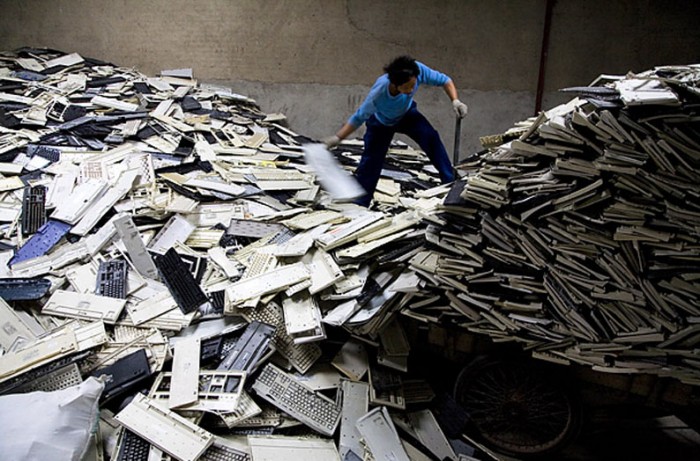In 2014, 41.8 million tons of electronic garbage were thrown into landfills. 48 million tons will be thrown in 2018
The UN released a report according to which, in 2014, the mass of e-waste generated, which includes devices with an electric cord and batteries, amounted to 41.8 million tons. In 2018, 48 million tons will be added to landfills, the report said . This is about 250 loaded container ships.
The cost of the materials from which the devices thrown into landfills are made is about $ 50 billion: among them are gold, silver, copper, iron.

The Chinese city of Guiyu, the largest place on the planet for the concentration and processing of electronic garbage.
In 2013, the StEP Initiative introduced an interactive map, representing the amount of electronic garbage per capita. Experts have suggested an increase in waste to 65.4 million tons per year until 2017. The organization named the USA and China as the main "producers" of this type of waste.
The forecast of the StEP Initiative has not yet been confirmed. In a report presented by the UN on April 19, the United States and China were again named leaders in terms of the mass of discarded equipment, and Norway is the leader per capita: a resident of this country emits 28 kilograms of electronics a year. The total mass of waste in 2014 amounted to 41.8 million tons, and in 2018 the UN predicts clogging of the planet with 48 million tons of new garbage.
Despite the rapid growth in the number of mobile devices and the frequency with which people change them, 60% of waste falls on household appliances. Every year, people throw out 18.8 million tons of refrigerators, washing machines and stoves - this is 470 thousand trucks with trailers loaded with medium-sized refrigerators.
Only 16% of e-waste is recycled. There are entire cities in the world that do this. One of them is Chinese Guiyu, which according to 2013 was the largest place on the planet for the concentration of human electronic waste. 150 thousand people live in the city and there are 5.5 thousand enterprises, mainly family workshops, which sort the garbage in parts, re-melt the metals and resell them. Every day, about a hundred trucks loaded with telephones, computers, and other electronics pass through the city.

The cost of the materials from which the devices thrown into landfills are made is about $ 50 billion: among them are gold, silver, copper, iron.

The Chinese city of Guiyu, the largest place on the planet for the concentration and processing of electronic garbage.
In 2013, the StEP Initiative introduced an interactive map, representing the amount of electronic garbage per capita. Experts have suggested an increase in waste to 65.4 million tons per year until 2017. The organization named the USA and China as the main "producers" of this type of waste.
The forecast of the StEP Initiative has not yet been confirmed. In a report presented by the UN on April 19, the United States and China were again named leaders in terms of the mass of discarded equipment, and Norway is the leader per capita: a resident of this country emits 28 kilograms of electronics a year. The total mass of waste in 2014 amounted to 41.8 million tons, and in 2018 the UN predicts clogging of the planet with 48 million tons of new garbage.
Despite the rapid growth in the number of mobile devices and the frequency with which people change them, 60% of waste falls on household appliances. Every year, people throw out 18.8 million tons of refrigerators, washing machines and stoves - this is 470 thousand trucks with trailers loaded with medium-sized refrigerators.
Only 16% of e-waste is recycled. There are entire cities in the world that do this. One of them is Chinese Guiyu, which according to 2013 was the largest place on the planet for the concentration of human electronic waste. 150 thousand people live in the city and there are 5.5 thousand enterprises, mainly family workshops, which sort the garbage in parts, re-melt the metals and resell them. Every day, about a hundred trucks loaded with telephones, computers, and other electronics pass through the city.

